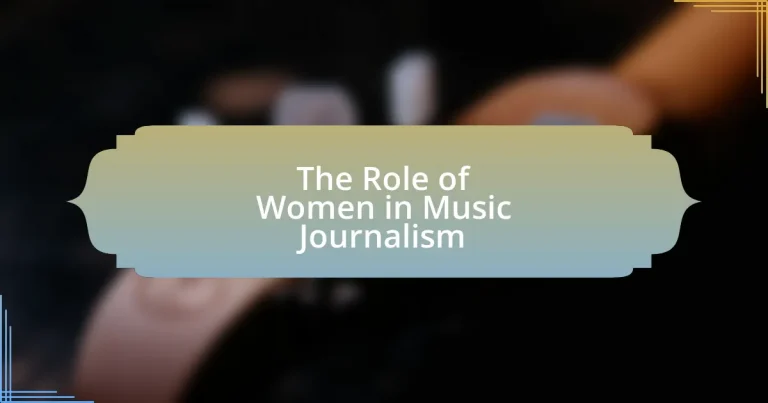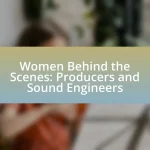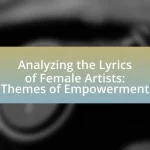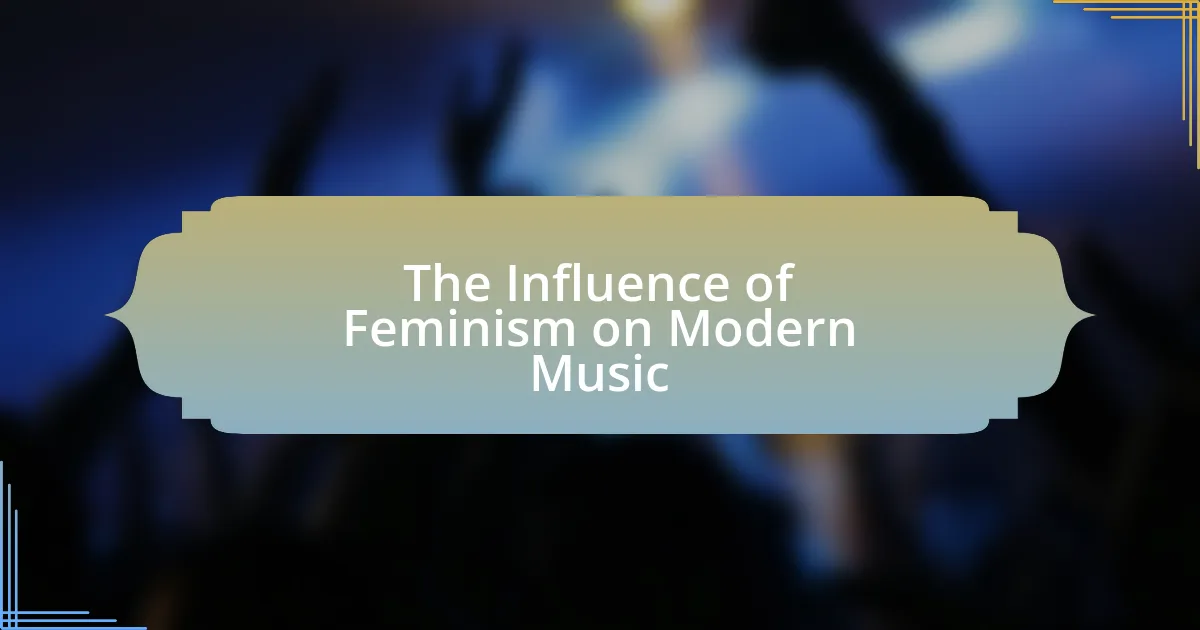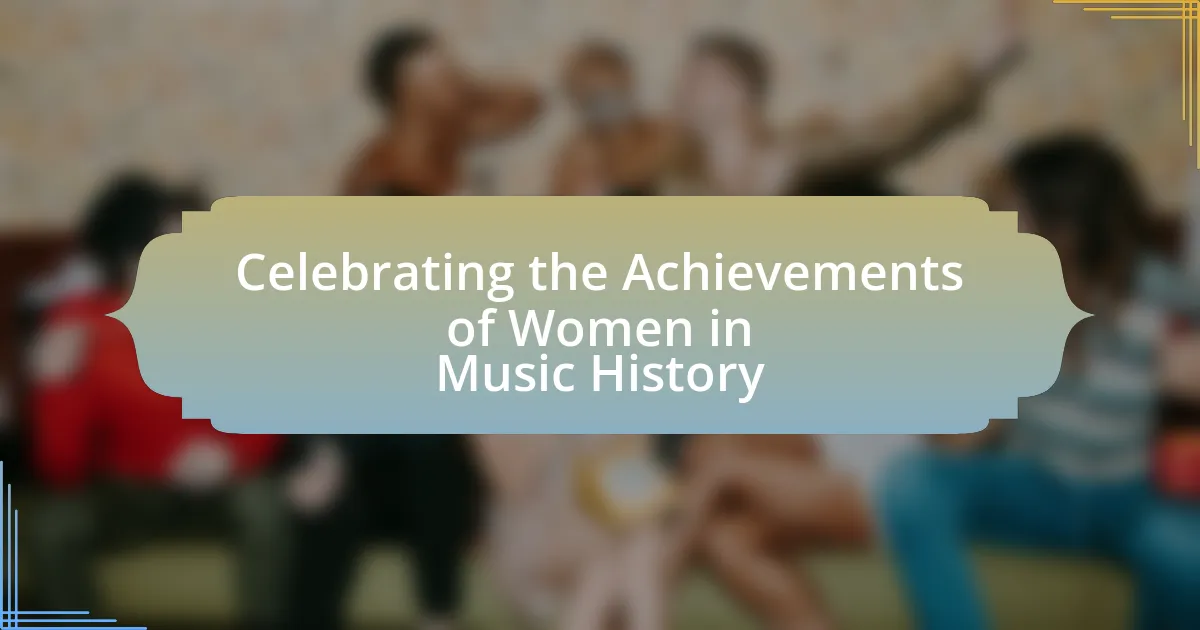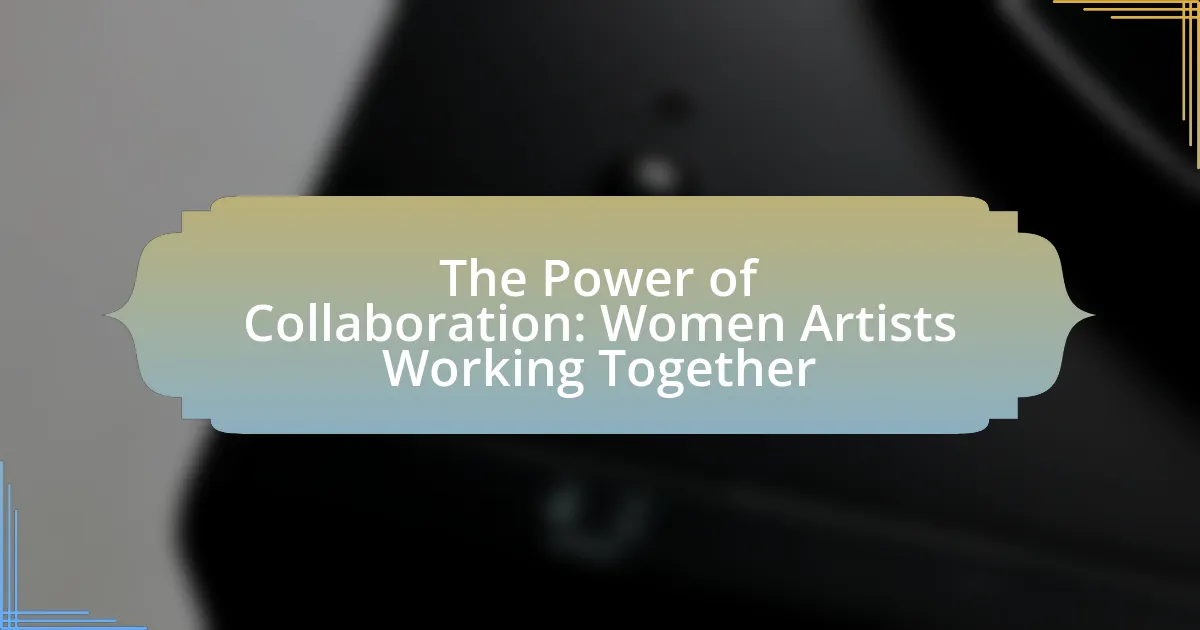The article examines the significant role of women in music journalism, highlighting their contributions to diverse perspectives, industry norms, and the amplification of underrepresented voices. It traces the evolution of women’s roles from marginalization to influential positions, noting historical milestones and societal changes that have shaped their participation. The article also addresses the challenges women face, including gender bias and underrepresentation, while emphasizing their impact on music criticism and discourse today. Additionally, it discusses initiatives supporting women in the field and outlines strategies for aspiring female journalists to navigate the industry successfully.
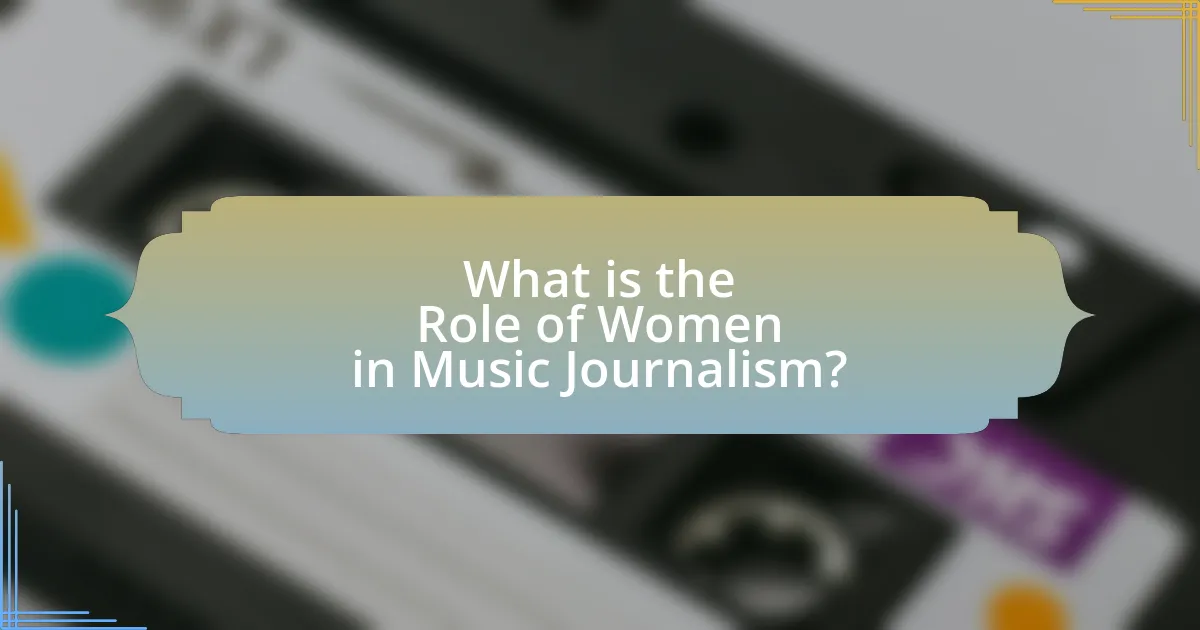
What is the Role of Women in Music Journalism?
Women play a crucial role in music journalism by providing diverse perspectives, challenging industry norms, and amplifying underrepresented voices. Their contributions have historically shaped music criticism, reporting, and cultural discourse, as evidenced by the increasing presence of women in prominent music publications and platforms. For instance, a study by the Annenberg Inclusion Initiative found that women comprised only 22.5% of music journalists in 2019, highlighting the ongoing need for gender equity in the field. Women journalists often focus on issues such as gender representation, social justice, and the experiences of female artists, thereby enriching the narrative landscape of music journalism.
How has the role of women evolved in music journalism over time?
The role of women in music journalism has evolved significantly from being marginalized to becoming influential voices in the industry. Historically, women faced barriers to entry in journalism, often relegated to supportive roles or excluded from major publications. However, from the 1970s onward, women began to assert their presence, with figures like Ellen Willis and Lisa Robinson paving the way for female critics and writers. By the 1990s and 2000s, the rise of feminist music criticism and the establishment of women-led publications further solidified their impact, leading to increased representation in mainstream media. Today, women not only contribute to music journalism but also shape cultural narratives, reflecting a broader societal shift towards gender equality in various fields.
What historical milestones have marked women’s contributions to music journalism?
Women’s contributions to music journalism have been marked by several historical milestones, including the establishment of influential publications and the emergence of prominent female critics. In the 1960s, women like Ellen Willis became notable for their work in publications such as The New Yorker, where Willis was one of the first female rock critics, providing a unique perspective on music and culture. The 1970s saw the rise of women like Lisa Robinson, who wrote for major outlets and interviewed top artists, further solidifying women’s presence in the field. Additionally, the founding of feminist music publications, such as “Rock She Wrote” in the 1990s, highlighted women’s voices and experiences in music journalism. These milestones reflect the growing recognition and impact of women in shaping music criticism and discourse.
How have societal changes influenced women’s participation in this field?
Societal changes have significantly increased women’s participation in music journalism by promoting gender equality and challenging traditional gender roles. The feminist movements of the 1960s and 1970s advocated for women’s rights, leading to greater representation in various fields, including journalism. According to a 2020 report by the Women’s Media Center, women now make up approximately 60% of journalism graduates, reflecting a shift in educational opportunities and societal acceptance. Additionally, the rise of digital media has provided platforms for women to express their voices and perspectives, further enhancing their visibility in music journalism.
What challenges do women face in music journalism?
Women in music journalism face several challenges, including gender bias, underrepresentation, and harassment. Gender bias manifests in the form of stereotypes that question women’s expertise and authority in music criticism, often leading to their work being undervalued compared to their male counterparts. Underrepresentation is evident in the lack of women in senior editorial positions, which limits their influence on music narratives and industry standards. Additionally, harassment, both online and in-person, creates a hostile environment that discourages women from pursuing careers in this field. According to a 2021 study by the Annenberg Inclusion Initiative, women make up only 22% of music journalists, highlighting the systemic barriers they encounter.
What barriers exist for women entering the music journalism industry?
Barriers for women entering the music journalism industry include gender bias, lack of representation, and limited access to networking opportunities. Gender bias manifests in the form of stereotypes that question women’s expertise and authority in music, often leading to their work being undervalued. A study by the Annenberg Inclusion Initiative found that only 22% of music journalists are women, highlighting the lack of representation in the field. Additionally, women often face challenges in networking due to male-dominated industry events, which can hinder their career advancement and access to influential contacts. These factors collectively create a challenging environment for women aspiring to succeed in music journalism.
How do gender biases manifest in music journalism?
Gender biases in music journalism manifest through the underrepresentation of women, stereotypical portrayals, and differential treatment in coverage. Research indicates that women journalists often face challenges in gaining equal visibility and credibility compared to their male counterparts, leading to a significant gender gap in bylines and featured articles. For instance, a study by the Annenberg Inclusion Initiative found that only 22.4% of music reviews were written by women, highlighting the disparity in representation. Additionally, women are frequently pigeonholed into specific genres or topics, such as pop or personal narratives, while men are more often associated with broader, more prestigious genres like rock or hip-hop. This bias not only affects the careers of female journalists but also shapes the narratives and perspectives presented in music journalism, reinforcing existing stereotypes and limiting the diversity of voices in the industry.
What impact do women have on music journalism today?
Women significantly influence music journalism today by diversifying perspectives and challenging traditional narratives. Their presence has led to increased representation of marginalized voices, fostering a more inclusive dialogue within the industry. For instance, studies show that publications with female editors and writers tend to cover a broader range of genres and artists, including those from underrepresented communities. This shift not only enriches the content but also attracts a wider audience, as seen in the growing readership of platforms like Pitchfork and NPR Music, which prioritize diverse voices. Furthermore, women in music journalism are actively reshaping discussions around gender equality, mental health, and social issues, thereby elevating the discourse in the field.
How do female music journalists shape music criticism and discourse?
Female music journalists shape music criticism and discourse by introducing diverse perspectives and challenging traditional narratives within the industry. Their contributions often highlight underrepresented voices and genres, thereby broadening the scope of music criticism. For instance, studies have shown that female critics frequently emphasize the importance of context, such as social and cultural factors, in their reviews, which can lead to a more nuanced understanding of music. Additionally, female journalists have been instrumental in advocating for gender equality in music, as evidenced by initiatives like the “Women in Music” organization, which aims to support and promote women in the industry. This advocacy not only influences discourse but also encourages a more inclusive environment for all artists.
What unique perspectives do women bring to music journalism?
Women bring diverse and nuanced perspectives to music journalism, often emphasizing themes of inclusivity, emotional depth, and social justice. Their unique experiences as listeners and creators allow them to highlight underrepresented voices and genres, such as women artists and marginalized communities. Research indicates that female music journalists are more likely to address issues like gender inequality and representation in the industry, as evidenced by studies showing that women comprise a significant portion of music critics who advocate for diverse narratives. This focus not only enriches the discourse around music but also challenges traditional norms within the field, fostering a more comprehensive understanding of the cultural landscape.
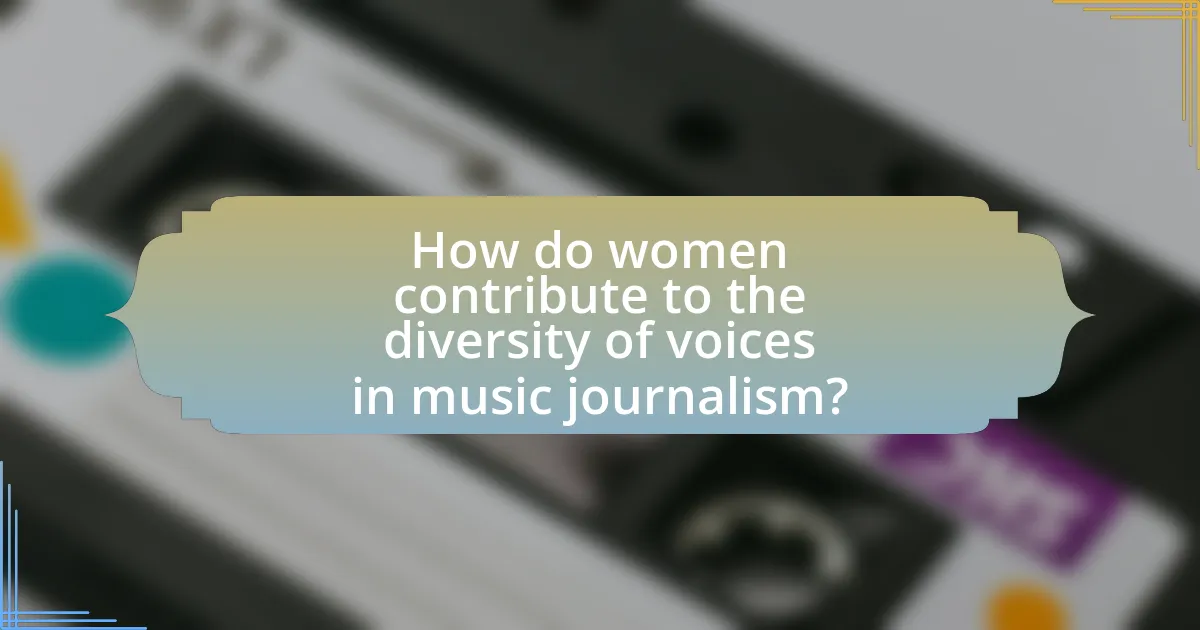
How do women contribute to the diversity of voices in music journalism?
Women contribute to the diversity of voices in music journalism by bringing unique perspectives, experiences, and insights that enrich the discourse surrounding music. Their involvement has led to a broader representation of genres, artists, and cultural contexts, which is essential for a comprehensive understanding of the music landscape. For instance, studies have shown that female music journalists often highlight underrepresented artists and genres, such as women in hip-hop and indie music, thereby challenging the male-dominated narratives prevalent in the industry. This shift not only diversifies the content but also fosters inclusivity, allowing for a more nuanced exploration of music’s impact across different demographics.
What role do women play in promoting underrepresented artists?
Women play a crucial role in promoting underrepresented artists by serving as advocates, curators, and journalists who amplify diverse voices in the music industry. Their involvement often leads to increased visibility for marginalized artists, as women in music journalism frequently highlight and review the work of these creators, thereby challenging mainstream narratives. For instance, studies have shown that female music critics are more likely to cover women and artists of color, contributing to a more equitable representation in media. This advocacy not only supports the artists but also enriches the cultural landscape by diversifying the narratives presented to audiences.
How do female journalists highlight diverse genres and cultures in music?
Female journalists highlight diverse genres and cultures in music by actively promoting underrepresented artists and genres through their writing and reporting. They often focus on storytelling that emphasizes cultural context, showcasing the significance of various musical styles and their origins. For instance, publications like Pitchfork and NPR Music feature female critics who spotlight genres such as Afrobeat, K-pop, and indigenous music, thereby broadening the narrative around music beyond mainstream pop. Research indicates that female journalists are more likely to cover diverse music scenes, contributing to a richer understanding of global music cultures and fostering inclusivity in the industry.
What initiatives exist to support women and marginalized voices in music journalism?
Initiatives that support women and marginalized voices in music journalism include organizations like the Women’s Audio Mission, which provides training and resources for women in audio and music production, and the Music Journalism Coalition, which advocates for equitable representation in music media. Additionally, platforms such as She Shreds Magazine focus on amplifying the voices of women guitarists and musicians, while initiatives like the Black Music Action Coalition work to address systemic racism in the music industry, including journalism. These organizations and platforms actively promote diversity and inclusion, ensuring that underrepresented voices are heard and supported in the field of music journalism.
How do women navigate the challenges of the music journalism landscape?
Women navigate the challenges of the music journalism landscape by leveraging their unique perspectives, building supportive networks, and advocating for representation. They often face gender bias and underrepresentation in the industry, which they counteract by creating platforms that amplify diverse voices and experiences. Research indicates that women in music journalism are increasingly forming collectives and mentorship programs to foster collaboration and share resources, thereby enhancing their visibility and influence. For example, initiatives like the Women in Music organization provide networking opportunities and professional development, helping women to overcome barriers and establish their presence in a traditionally male-dominated field.
What strategies do women use to overcome industry obstacles?
Women in music journalism employ several strategies to overcome industry obstacles, including building strong networks, advocating for representation, and leveraging digital platforms. Networking allows women to connect with mentors and peers who can provide support and guidance, which is crucial in a male-dominated field. Advocacy for representation helps to challenge stereotypes and push for more inclusive practices within media organizations. Additionally, utilizing digital platforms enables women to create their own content and reach audiences directly, bypassing traditional gatekeeping mechanisms. These strategies are supported by research indicating that women who actively engage in networking and digital content creation report higher levels of career satisfaction and success in overcoming barriers in the industry.
How do mentorship and networking impact women’s success in music journalism?
Mentorship and networking significantly enhance women’s success in music journalism by providing essential guidance, support, and opportunities for professional growth. Women who engage in mentorship relationships often gain access to industry insights and career advice that can help them navigate challenges unique to the field. For instance, a study by the Women’s Media Center found that women with mentors are more likely to secure leadership positions and have increased job satisfaction. Networking allows women to build connections with industry professionals, leading to collaborations and visibility that can elevate their careers. Research indicates that women in music journalism who actively participate in networking events report higher levels of career advancement and recognition, demonstrating the critical role these elements play in fostering success.
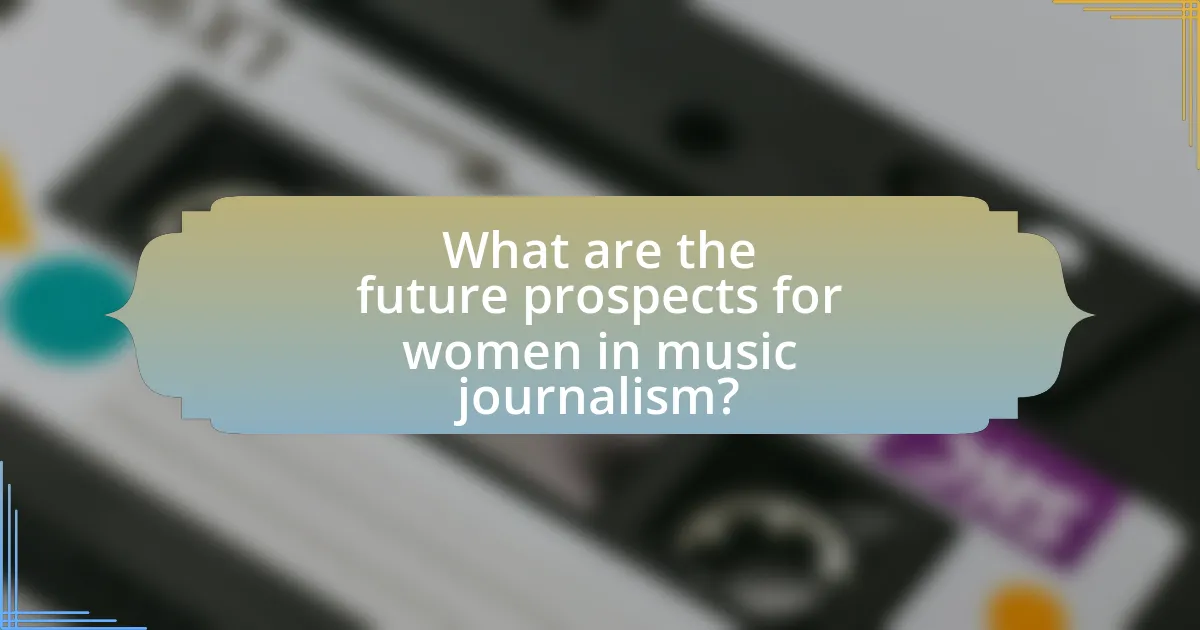
What are the future prospects for women in music journalism?
The future prospects for women in music journalism are increasingly positive, driven by a growing emphasis on diversity and representation within the industry. Research indicates that women are gaining more visibility in editorial roles and are being recognized for their contributions, as evidenced by the rise of female-led music publications and initiatives aimed at supporting women in media. For instance, organizations like She Shreds and Women in Music are actively promoting female voices, which enhances opportunities for women to influence music journalism. Additionally, the increasing demand for varied perspectives in music criticism suggests that women will continue to play a crucial role in shaping the narrative of music journalism moving forward.
How is the landscape of music journalism changing for women?
The landscape of music journalism is increasingly becoming more inclusive for women, as evidenced by the rise of female voices in prominent publications and platforms. Women are now holding key editorial positions and contributing significantly to music criticism, which was historically dominated by men. For instance, a 2021 study by the Annenberg Inclusion Initiative found that women accounted for 30% of music critics in major publications, a notable increase from previous years. Additionally, initiatives aimed at supporting women in media, such as the Women in Music organization, are fostering mentorship and networking opportunities, further empowering women in the field. This shift reflects a broader cultural recognition of the importance of diverse perspectives in music journalism.
What trends indicate a shift towards greater inclusion of women in music journalism?
Trends indicating a shift towards greater inclusion of women in music journalism include an increase in female bylines in major publications and the rise of women-led media platforms. Research by the Women’s Media Center in 2021 revealed that women accounted for 50% of music journalism bylines in prominent outlets, a significant increase from previous years. Additionally, initiatives such as mentorship programs and diversity grants aimed at supporting women in the field have gained traction, further promoting gender equity in music journalism. These trends collectively demonstrate a growing recognition of the importance of women’s voices and perspectives in the industry.
How can aspiring female journalists prepare for a career in music journalism?
Aspiring female journalists can prepare for a career in music journalism by gaining relevant experience through internships, writing for music blogs, and networking within the industry. Internships provide hands-on experience and industry insights, while contributing to music blogs helps develop writing skills and a personal voice. Networking with established journalists and attending music events can open doors to opportunities and mentorship. According to a study by the Women’s Media Center, women remain underrepresented in media, highlighting the importance of female voices in music journalism to promote diverse perspectives.
What best practices can support women in music journalism?
Best practices that can support women in music journalism include promoting equitable hiring practices, providing mentorship opportunities, and fostering inclusive work environments. Equitable hiring practices ensure that women are represented in editorial positions, which can be backed by studies showing that diverse teams produce better outcomes. Mentorship opportunities connect emerging female journalists with experienced professionals, enhancing skill development and career advancement. Additionally, fostering inclusive work environments encourages open dialogue and collaboration, which research indicates leads to increased job satisfaction and retention rates among women in the industry.
How can media organizations foster a more inclusive environment for women?
Media organizations can foster a more inclusive environment for women by implementing equitable hiring practices and promoting diverse voices in their content. Research shows that organizations with gender-diverse teams are 15% more likely to outperform their peers (McKinsey & Company, 2020). By actively recruiting women for leadership roles and ensuring representation in editorial decisions, media organizations can create a culture that values women’s perspectives. Additionally, providing mentorship programs and professional development opportunities specifically for women can enhance their visibility and career advancement in music journalism.
What resources are available for women pursuing careers in music journalism?
Women pursuing careers in music journalism can access various resources, including mentorship programs, professional organizations, and educational opportunities. Organizations like the Women’s Audio Mission provide training and support specifically for women in audio and music fields. Additionally, the Association for Women in Music offers networking and professional development resources. Educational institutions often have programs focused on music journalism, and online platforms like Coursera and MasterClass provide courses taught by industry professionals. These resources collectively empower women to build successful careers in music journalism.
